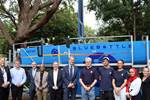Lockheed Martin invests $50 million in Saildrone platform
Composites-intensive technology will advance the U.S. Navy’s unmanned surface vehicle (USV) capabilities.
Saildrone Surveyor SD-3004 sails in the San Francisco Bay. Source | Saildrone
(Bethesda, Md., U.S.) has announced its $50 million investment in maritime autonomous systems company (Alameda, Calif., U.S.). This strategic collaboration will deliver commercially available unmanned surface vehicles (USV) equipped with combat-proven defense technology. The companies will collaborate with a goal of delivering integrations, including on-water, live fire demonstrations, in 2026.
This commercial relationship marries sophisticated and trusted defense technology with capable and operationally tested USV technology. The combination will be key to realizing the U.S. Navy’s USV vision for critical missions such as fleet defense, undersea surveillance, reconnaissance and more. Work will begin immediately, applying an open architecture approach along with secure command and control capability to integrate Lockheed Martin’s JAGM Quad Launcher (JQL) system onto the Saildrone Surveyor platform.
Larger Saildrone vehicles are already in development to support significantly larger payloads and capabilities to include the Lockheed Martin Mk70 VLS launcher and thin line towed arrays.
“For the last 10 years we have focused on evolving the reliability, endurance and autonomy of the Saildrone platform, which has been demonstrated in over 2 million nautical miles of active customer missions,” says Richard Jenkins, founder and CEO of Saildrone.
The Saildrone Voyager platform, which earned ISO 9001 certification earlier this year, makes ample use of composites.
Saildrone USVs have been accomplishing complex maritime missions in the remote ocean since 2013. First deployed by the U.S. Navy in 2021, they are currently operational today. This commercial relationship will harness Saildrone’s decade-plus of commercial expertise to quickly field new defense applications. Saildrone will maintain all shipbuilding responsibilities and Lockheed Martin will serve as lead mission integrator.
Related Content
-
The AAMMC Tech Hub: Ramping U.S. production of large thermoplastic composite aerostructures
CW talks with Syensqo, Spirit AeroSystems and other consortia members about current funding, specification of the next world’s largest press, organizational structure and projects to support U.S. companies in the race to deliver >40,000 sustainable and efficient aircraft over the next 20 years.
-
Industrializing additive manufacturing in the defense/aerospace sector
GA-ASI demonstrates a path forward for the use of additive technologies for composite tooling, flight-qualified parts.
-
“Structured air” TPS safeguards composite structures
Powered by an 85% air/15% pure polyimide aerogel, Blueshift’s novel material system protects structures during transient thermal events from -200°C to beyond 2400°C for rockets, battery boxes and more.






